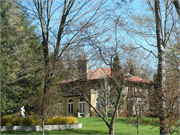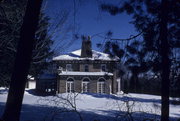| Additional Information: | A 'site file' exists for this property. It contains additional information such as correspondence, newspaper clippings, or historical information. It is a public record and may be viewed in person at the Wisconsin Historical Society, State Historic Preservation Office.
Walter Fromm made his fortune raising foxes and ginseng. He and his brothers first grew ginseng and exported it to China, where the root had long been prized for its medicinal value, then used the profits to start their fox-breeding operation. They later joined their relatives, the Niemans, to form the Fromm Brothers-Nieman Company, and by 1928 their firm ranked as the nation’s leading breeder of silver foxes. When the fashion for silver fox fur waned, the company switched to mink and became leading breeders of that species.
At the pinnacle of his success, in 1928, Walter commissioned this stately two-story residence. Its tan brick walls, wide-overhanging bracketed eaves, and low-pitched roof with clay barrel tiles and semicircular dormer vaguely recall the Mediterranean Revival style. So do the simple wrought-iron balconets beneath the second-story windows, and the more elaborate wrought-iron balcony that crowns the narrow Ionic-columned entry porch. A rectangular solarium stretches to the west, its walls pierced by pairs of French doors. Semicircular stained-glass lights, decorated in a floral pattern, surmount these entrances.
The house’s exterior barely hints at the opulence inside. Perhaps Fromm envied the breathtaking artwork in the newly built home of his brother-in-law and business partner, Edwin Nieman. In 1932, Fromm commissioned Friedrich Estenfelder, a German immigrant, to decorate the mansion’s interior. The artist stenciled the ceilings with floriated patterns and adorned the walls with artistic textures and rich finishes. In the living room, stenciled floral patterns decorate the beams and the plastered spaces in between. An ornate wrought-iron gate, whose frame is carved in ginseng-plant motifs, opens onto the dining room. Here, Estenfelder gilded the coved molding around the edges of the ceiling with gold-leaf fleurs-de-lis, daisies, lions, and eagles set against a blue background. A stenciled heraldic motif marks each ceiling corner, and four brass sconces match the stunning Art Deco chandelier. The artist painted the highly textured plaster walls of the dining room to create an ethereal smokey effect: the walls take on shades of maroon at the bottom but gradually blend into beige. In the solarium, Estenfelder created an ingenious maple-leaf pattern, in which pale-hued leaves fall gently from the tops of the walls, alighting, piling upon, and finally crushing one another to create a progressively deeper, denser mass as the eye moves toward the floor. A richly carved vine pattern winds across the stone ogee-arched mantelpiece surrounding the fireplace.
Estenfelder’s exuberant artistry extends beyond the public rooms to cover almost every interior surface. Even the basement billiards room has hand-painted scenes of hollyhocks and butterflies in framed panels, and painted squirrels perch on evergreen branches in the backs of alcove seats. |
|---|





